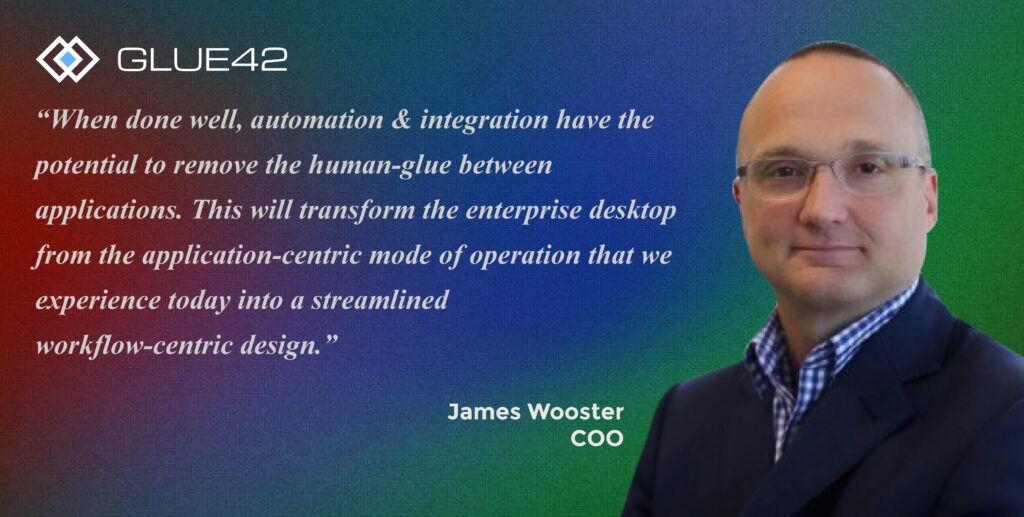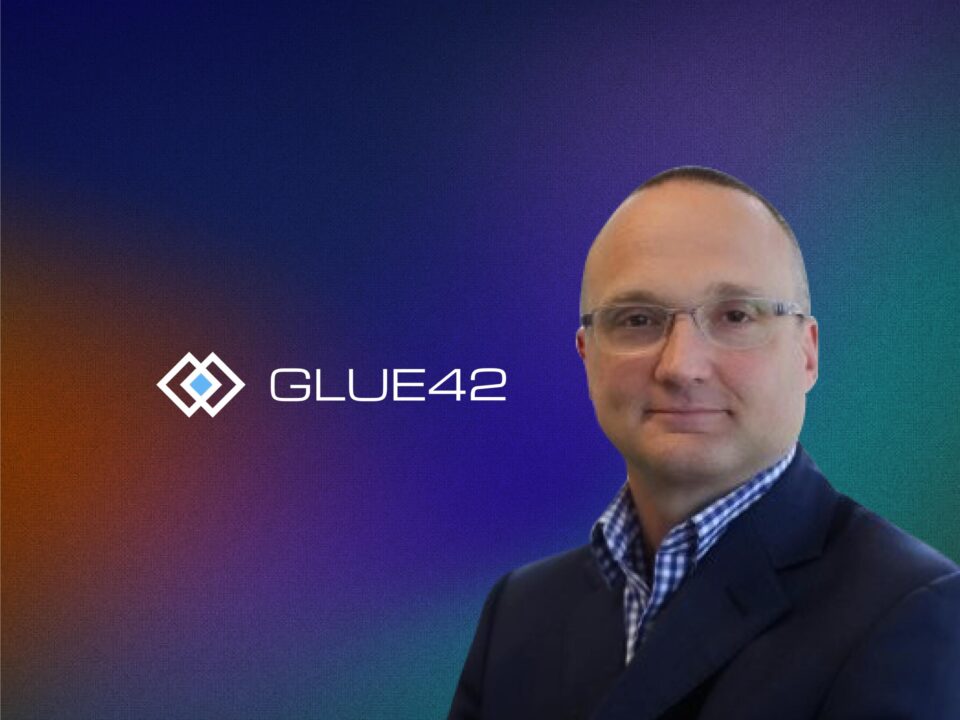
Hi, James, please tell us about your journey into technology and what inspired you to start at Glue42 platform.
I began my career on the technical side of the house, working through a variety of roles including developer, architect and design authority. During the mid 90s, I became aware of the emergence of ‘middleware’ platforms and decided to join one of the very first protagonists in that space – ‘Vitria’. Bit by bit I moved towards the ‘dark-side’ through presales into sales and ultimately sales & operations management. Thankfully, I’ve not looked back and retain a passion for all thing’s ‘integration’.
Glue42 sits in a really interesting and fast-growing part of the integration landscape. Our mission is to integrate client-side (desktop) applications into unified workspaces. We sit at the nexus of application re-use, UI orchestration, data interoperability, micro-frontend and low-code environments. For our clients, they are able to improve productivity, develop new applications faster and prevent themselves from being locked-in to new (or old) technologies.
Could you elaborate on the recent developments in the open source platforms? How would the Open Source platforms influence innovations within the financial institutions?
When I first joined Glue42 our part of the integration market spoke a great deal about the importance of open standards and open-source initiatives – but there was not a great deal of substance. Last year, we took the decision to open-source the most commonly used part of our platform – specifically the ability to integrate web-applications. This, combined with the new web application development frameworks supported by Google and Microsoft has made it possible to implement robust enterprise-grade solutions without busting the IT budget.
Open-source has therefore lowered the barrier to entry allowing many more organizations to take advantage of the technology. What has been interesting is the willingness of firms to actively engage in these open-source projects. For them and their employees, open-source activity brings with it a level of respect and community that would have been impossible to achieve otherwise.
Read More: Global Fintech Interview with Sushil Prabhu, CEO and Chairman at Dropp
Digital transformation has become a priority for banks and financial institutions. Could you tell us how Glue42 simplifies customer efforts relating to digital transformation journeys?
Desktop Integration Platforms (DIPs) are an integral part of a digital transformation program. The clue to their relevance is the word ‘Transformation’. DIPs allow old, new, in-house and third-party applications to be integrated together without needing to embark upon costly rewrites. This means assets can be sweated while an incremental approach is taken to deliver improved business operations. Better still, because of this ability to integrate anything, future application developments can be performed in the knowledge that their obsolescence can also be delayed.
Tell us how Fintech organizations benefit from Desktop Unification / Automation platform that you provide?
In the context of a financial institution (e.g. bank, hedge fund, trading house), there are four sets of beneficiaries of desktop unification and automation (users, operations, IT and the business).
Users (e.g. traders, portfolio managers, heads of desk etc) – the human-glue that stick disparate applications together. They will need to navigate within and across application boundaries, copy/pasting and searching for information as none of their applications are aware of each other. This ‘swivel-chair’ integration is costly in terms of wasted effort, user confusion and the potential for errors.
Operations – benefit from improved levels of efficiency, reduced cost of training and higher customer satisfaction.
IT – desktop integration (when done using a full-service stack) offers the ability to seamlessly integrate applications of any age/technology together. This can be used (a) to accelerate application development through greater levels of re-use and/or (b) sweat/decompose/re-use existing assets to avoid application rewrites.
Business – reduced time to market for new products / services given that IT are better able to deliver, IT can move faster, operations have bandwidth and users can learn new processes quickly.
In addition, Desktop Integration is also used by software vendors to integrate their own applications. They often appreciate similar benefits, but in addition, their Product Management and Engineering teams can improve the usability of their applications and also offer to market a fully integrated application platform.
What kind of training and support does Glue42 provide to customers to improve user experience?
In most client engagements, Glue42 will provide both software and consulting services to achieve early success and exemplar projects. We do this through architect/developer training, creation of centres-4-enablement and configuration of company specific design/build and operate methodologies. In terms of user-experience, we have extensive knowledge of best practices, design systems and UI/UX guidelines to achieve simple to use and intuitive experiences.
Your prediction on the future of desktop automation in the next 3-5 years:
When done well, automation & integration have the potential to remove the human-glue between applications. This will transform the enterprise desktop from the application-centric mode of operation that we experience today into a streamlined workflow-centric design. Application boundaries will be blurred, workspaces (which act as hosts for applications and application components) will be pre-populated using relevant contextual data and users will focus on the job in hand, not get bogged down in the intricacies of inconsistent and un-integrated applications. We like to say that the application is dead – long live the workspace! Thinking further ahead, automation and integration services will ultimately become part of the operating system. Windows (or more likely Chrome) PCs will manage application groups and workspaces in the way we think of singular applications today.
Read More: Global Fintech Interview with Todd Bonner, Co-Chairman at NextPlay Technologies
Tell us more about the innovative fintechs / fintech platforms that you are keenly following:
This may come as a surprise, but we love what Bloomberg are doing with their platform. They’ve acknowledged the need for APIs for both frontend desktop clients as well as the backend data-services. This allows a Desktop Integration Platform to weave seamless workflows between their applications and others – such that they can share data context and simplify the user-experience. Traders love this approach. In times of extreme market volatility, have all desktop applications synchronized together in real-time is critical for generation of Alpha.
Your take on the evolution of Fintech industry amid the ongoing pandemic-enforced disruptions:
Our part of the fintech realm was largely unaffected by the pandemic. Looking back, I think this was in part due to our focus on the end-user – the trader, portfolio manager, risk manager etc. The need to move their multi-screen desktop environments from the office to the home required a step-change in how to deliver productive user-experiences. Integration of their applications and simplification of the workflows – is exactly what DIPs are designed for. Going forward, I think those fintechs that retain their agility to respond to unforeseen demands will continue to thrive. I am not sure we have fully seen the back of the pandemic(s) yet…
Read More: Global Fintech Interview with Brent Stringer, Chief Financial Officer at Verusen
Your advice to business leaders in the industry:
My favorite lesson learnt in the last year has been the need to focus on the details. The technology that underpins a Desktop Integration Platform is important – but the design of the resultant workflow is critical. Engineering simple workflows is a complex business – and one beyond the reach of most application developers. UX experts are very expensive resources – but without them productivity gains would be very difficult to achieve.
Thank you, James! That was fun and we hope to see you back on globalfintechseries.com soon.
[To share your insights with us, please write to sghosh@martechseries.com]
James is COO of Glue42, a provider of desktop integration platforms. He has an extensive background in software integration solutions and spent his formative years in a variety of development and architecture roles. Since then, he has run field operations & sales organisations for software integration businesses including SAP’s UK, Software AG Australia and TIBCO UK.
Glue42 enables organizations to build intelligent desktops that support configurable workflows between web and desktop applications. Its integration platform seamlessly and securely orchestrates UI and data and leverages open-source initiatives such as FINOS FDC3 to reduce application delivery times and accelerate time to value. The company is based in London, New York and Bulgaria. With over 35,000 licenses, its software is deployed at tier one financial institutions across the world.

